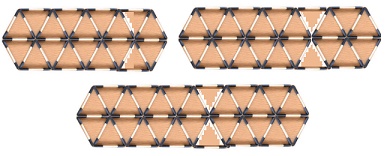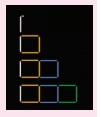Information Processing | Term 2 Chapter 5 | 7th Maths - Tables and Patterns Leading to Linear Functions | 7th Maths : Term 2 Unit 5 : Information Processing
Chapter: 7th Maths : Term 2 Unit 5 : Information Processing
Tables and Patterns Leading to Linear Functions
Tables and Patterns Leading to Linear Functions
Situation 1
Observe the following pattern
Consider a circular disc ![]() .
Circular rings of same width are drawn around the disc
.
Circular rings of same width are drawn around the disc  . Proceed in
the same way to get the shapes following a pattern as shown below.
. Proceed in
the same way to get the shapes following a pattern as shown below.

Let us express the above pattern of shapes
in the form of a table.
Let x denote the number of steps
and y denote the total number of circular rings.

Here let us find the relationship between
the number of steps and number of circular rings.
Hence the relationship between x
and y can be generalised as y = 2x ŌĆō1
Situation 2
Consider an equilateral triangle of any
size  . Mark the midpoints of sides of a triangle and join them to form
four equilateral triangles
. Mark the midpoints of sides of a triangle and join them to form
four equilateral triangles ![]() . Proceed in the same way to get the shapes
following a pattern as shown below.
. Proceed in the same way to get the shapes
following a pattern as shown below.

Let us express this repeated process
in the form of a table.
Here let us find the relationship between
the number of steps (x) and total number of vertices (y).

Hence, the relationship between x
and y can be generalised as y = 3 ├Ś ( 2x ŌłÆ1 ).
From the above situations, you could
have understood that even if an action is repeatedly done, the properties of the
shape do not change.
Example 5.1
In the following figures, polygons are
formed by increasing the number of sides using matchsticks as given below.

Find the number of sticks required to
form the next three shapes by tabulation and generalisation.
Solution
In the above pattern of polygons, in
the first shape (x = 1 ), we get a closed shape called a
triangle. Similarly the second shape ( x = 2 ) gives a four sided
polygon and the third shape ( x = 3 ) is a five sided polygon and continuing
in the same way two more shapes are formed. If the number of match sticks required
to form each of the shapes is taken as y, then the values of x and
y are tabulated as given below.

Observe the table and express y
in terms of x as below :
when x = 1 , y = 3 = 1+2
when x = 2 , y = 4 = 2+2
when x = 3 , y = 5 = 3+2
when x = 4 , y = 6 = 4+2
when x = 5 , y = 7 = 5+2
Hence, each of the values of y
which we get from the table is 2 more than x. That is y =
x +
2 .
Therefore,
6th shape (x=6) will have y
= 8 = 6+2 (8 match sticks)
7th shape (x=7) will have y
= 9 = 7+2 (9 match sticks)
8th shape (x=8) will have y
= 10 = 8+2 (10 match sticks)
We clearly see that the next three shapes
will require 8, 9 and 10 matchsticks.
Activity
Observe the pattern given
below. Continue the pattern for three more steps.


Let, ŌĆśxŌĆÖ be the number of steps and ŌĆśyŌĆÖ be the number of match sticks. Tabulate the values of ŌĆśxŌĆÖ and ŌĆśyŌĆÖ and verify the relationship y = 7x+5.
Try these
1. In the given figure, let x denote the number of steps and
y denote its area. Find the relationship between x and y by
tabulation.

Solution:

The relationship between x and y is,
y = x2
2. In the figure, let x denotes the number of steps and y
denotes the number of matchsticks used. Find the relationship between x and
y by tabulation.

Solution:

The relationship between x and y is,
y = 3x ŌĆō 2
3. Observe the table given below.

Find the relationship between x and y. What will be the value of y, when x = 8.

The relationship between x and y is, y = 2x.
when x = 8, y = 16.
Related Topics